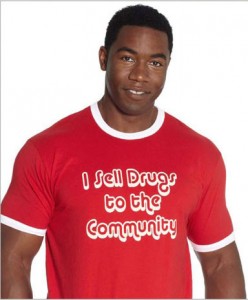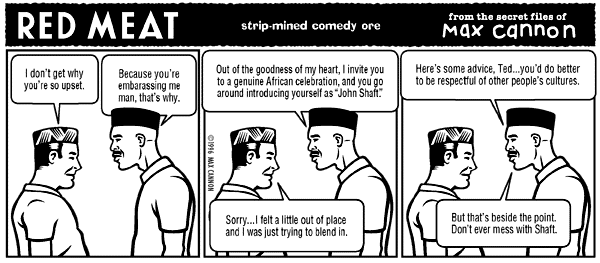If there’s one thing I like as much as noir, it’s blaxploitation films. Cotton Comes to Harlem was one I hadn’t seen before I found it on Youtube last week.
The novel had funny moments, but the movie seemed to really play up the comedic aspects. Part of that, for me, was recognizing so many of the actors. Redd Foxx, who played the junk collector, later played a junk collector on TV in Sanford and Son. I thought the lady with the hole in her skirt was Aunt Esther from the same show, but I’m pretty sure I was mistaken. Coffin and Grave Digger’s boss later played Leslie Neisen’s boss on Police Squad!. And Godfrey Cambridge, who played Grave Digger, I recognized from Watermelon Man, where he played a white racist who woke up one day to find he had turned into a black man. Surprisingly, Watermelon Man and Cotton Comes to Harlem were both released on 27 May 1970 according to IMDB.
I’m curious as to why Ossie Davis went for funny rather than gritty or hardboiled. He could have had commercial, cultural or aesthetic reasons. I looked (not trying too hard) for articles about Davis and the film from 1970-71. I found an article from the LA Times that said up until that year “blacks … had little or no movie image,” meaning they were very rarely on screen. I don’t know how accurate that is. It could be that black cinema (other than Sidney Poitier) was not on the reporter’s radar.
Writing a generally negative review in the New York Times, Vincent Canby noticed that the film audience rooted for Deke O’Malley rather than Coffin and Grave Digger. Judging from the way they laughed when the detectives told Deke he could have been another Garvey or Malcolm, he writes that “the audience … was simply disappointed that crime did not pay.” As police detectives, Coffin Ed and Grave Digger represent The Man more than the people of Harlem, whereas Deke is a hustler trying to get ahead. Himes himself said that Deke was meant to be the central character, not the detectives. The audience probably did not sympathize with the victims of Deke’s scam because they were really only victims of their own foolishness.
Does blaxploitation means exploiting the black audience, or exploiting black sterotypes? Hollywood found that movies geared towards black audiences could be very profitable, earning half a billion dollars in today’s money back in 1972.
While audiences were voting in favor of these movies with their wallets, others were criticizing them for the image of black America they displayed. In Hollywood Shuffle, Robert Townsend satirized black stereotypes in film. Public Enemy criticized the racial caricatures displayed in movies in the song Burn Hollywood Burn. The song concludes with a decision to watch Black Caesar, a movie about a criminal gang leader, instead.
 Of course, I can’t write about blaxploitation without a shout out to what is possibly the best movie ever made, which has six word story t-shirts of its own. It’s not every day you get to see Nixon with nunchucks.
Of course, I can’t write about blaxploitation without a shout out to what is possibly the best movie ever made, which has six word story t-shirts of its own. It’s not every day you get to see Nixon with nunchucks.



What’s got me excited this time around with Cotton Comes to harlem is getting into the Blaxploitation films with the class. It’s pretty common to frame Shaft or Sweet Sweetback’s Badaaaaaas Song as the first Blaxploitation film, whereas Cotton Comes to Harlem is almost a year earlier. What’s more, the crazy acrobatics of the Easy flying through the air was enough to make me think of crazy camp Blaxploitation films like Dolemite.
I have a second post about Ossie Davis, the absence of the Colonel, and some lineage to Spike Lee. The lineage to Boyz in the Hood with the black capitalism vision of the film has another tributary through the earlier Do the Right Thing, and I am fascinated by how much Ossie Davis informs Spike Lee, even in his use of black face in the film Bamboozled.
I loved the Vincent Candy review you found about the audience siding with Deke. I really loved Deke’s reverend like sermons at the beginning of the film, they reminded me a lot of Cyrus from The Warriors. Another interesting strand running through Blaxploitation is the counter-movement in the 70s and 80s in LA and elsewhere in which young black filmmakers started challenging (and at times playing within) the genre. The schools was called the L.A. Rebellion and I got into last Spring when I stumbled onto Emma Mae in Austin, Texas. There is still so much about Blaxploitation that is yet to be imagined and written, and with the advent of hip hop it has just gotten that much richer.
One of the things that fascinated me about Bamboozled was that when I heard people talk about the Chappelle Show it seemed like a bizarre case of life imitating art.
I saw that post about LA Rebellion before. Now I’ve added Emma Mae to my queue. Thanks for that.
The Chappelle Show is a whole ‘nother layer to this. Not only its brilliance, but his subsequent extraction of himself from comedy because, like Blaxploitation, he framed it as racist in its stereotypes as a media conglomerate reality. Trippy stuff there, and the ways in which we start to work through the idea of racial caricatures from black race to the racial draft is its own class all told.